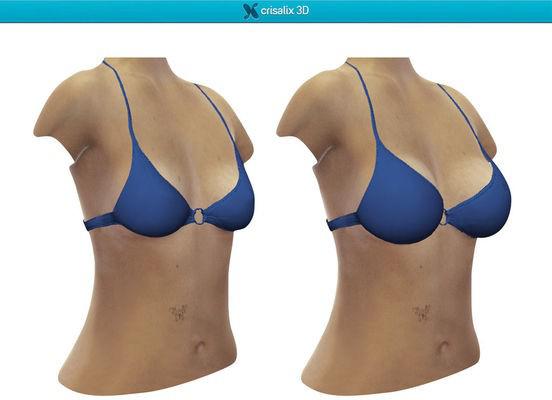
Breast augmentation is a procedure to increase the size or improve the shape of the breasts, through the insertion of implants. The implants are available in a number of sizes and a choice of shapes, to achieve the desired results for the patient. The procedure can also be used to restore breast volume that has been lost after a person has undergone significant weight loss or pregnancy.
A woman’s relationship with her breasts is a very personal one. It can be tied up in self-esteem or self-image and the results of an augmentation can be very satisfying for the patient. There is huge interest in breast augmentation and I would say it’s one of the most common surgeries I perform. It is also one with a very high patient satisfaction rate.
Perhaps contrary to what you might think, the incision needed for the insertion of an implant is quite small. It is made in one of several areas, usually the crease under the breast (inframammary), around the nipple (periareolar) or under the arm (transaxillary). The implant can be placed either on top of the pectoralis muscle and under the breast tissue or partially under the pectoralis muscle.
I use the Dual Plane technique for the majority of my primary (1st time) breast augmentation cases. This technique allows two pocket planes (Dual Plane) to be developed in a patient, which offers additional benfits and fewer of the disadvantages of a single pocket location.1
There are two shapes of implant available: round and the more anatomically-correct looking teardrop shape. I find the round implant is more popular with my patients. The Dual Plane Breast Augmentation Surgery is performed under general anesthetic and usually takes about an hour and a half to two hours. Patients can generally go home the same day. Some aftercare is needed and a follow up appointment will be made to make sure everything is going well.
Along with a full clinical exam and explanation of the risks and processes involved in a breast augmentation procedure, a very important aspect of this surgery is that the patient fully understands what is achievable.
It is not as simple as just inserting an implant; the breast is very personal to each individual and is a three-dimensional structure. Not only does the implant need to be correct in dimensions (base width, height and projection) and size, it must fit well with the patient’s own aesthetic and their overall body shape.
It’s also key that a patient appreciates what their desired changes will look like – it can be difficult to gauge how big a cup size is without accurate visual aids, or how an implant will look in situ.

However, advances in technology have brought significant improvement during the consultation phase. In my practice, I use Crisalix technology and my clinic is one of only three places in Dublin, Ireland to do so. Its advanced 3D imaging technology means a patient can ‘see’ what their breasts will look like after surgery, from all angles. I take a 3D scan of the patient’s body and can then sit with them, showing them gradual changes in size and shape, and what their breasts will look like from every angle.
As I mentioned, patient satisfaction when it comes to breast augmentation surgery is very high. The patient can usually return to normal activities after about two weeks, with more vigorous, sporting activities approximately four weeks after that. Scarring in most cases is minimal.
If you are considering breast augmentation or any other cosmetic surgery procedure, we can advise on the best options for you. Contact us to arrange a consultation.
Find out all you need to know about cosmetic procedures and the factors you need to consider in our free guide: Considerations Before Deciding on Cosmetic Surgery and Post-Treatment Care:
Download Mr. Chan's Guide to Cosmetic Surgery Considerations
Tebbetts JB.
Plast Reconstr Surg. 2001 Apr 15;107(5):1255-72

Breast augmentation is a procedure to increase the size or improve the shape of the breasts, through the insertion of implants. The implants are available in a number of sizes and a choice of shapes, to achieve the desired results for the patient. The procedure can also be used to restore breast volume that has been lost after a person has undergone significant weight loss or pregnancy.
A woman’s relationship with her breasts is a very personal one. It can be tied up in self-esteem or self-image and the results of an augmentation can be very satisfying for the patient. There is huge interest in breast augmentation and I would say it’s one of the most common surgeries I perform. It is also one with a very high patient satisfaction rate.
Perhaps contrary to what you might think, the incision needed for the insertion of an implant is quite small. It is made in one of several areas, usually the crease under the breast (inframammary), around the nipple (periareolar) or under the arm (transaxillary). The implant can be placed either on top of the pectoralis muscle and under the breast tissue or partially under the pectoralis muscle.
I use the Dual Plane technique for the majority of my primary (1st time) breast augmentation cases. This technique allows two pocket planes (Dual Plane) to be developed in a patient, which offers additional benfits and fewer of the disadvantages of a single pocket location.1
There are two shapes of implant available: round and the more anatomically-correct looking teardrop shape. I find the round implant is more popular with my patients. The Dual Plane Breast Augmentation Surgery is performed under general anesthetic and usually takes about an hour and a half to two hours. Patients can generally go home the same day. Some aftercare is needed and a follow up appointment will be made to make sure everything is going well.
Along with a full clinical exam and explanation of the risks and processes involved in a breast augmentation procedure, a very important aspect of this surgery is that the patient fully understands what is achievable.
It is not as simple as just inserting an implant; the breast is very personal to each individual and is a three-dimensional structure. Not only does the implant need to be correct in dimensions (base width, height and projection) and size, it must fit well with the patient’s own aesthetic and their overall body shape.
It’s also key that a patient appreciates what their desired changes will look like – it can be difficult to gauge how big a cup size is without accurate visual aids, or how an implant will look in situ.

However, advances in technology have brought significant improvement during the consultation phase. In my practice, I use Crisalix technology and my clinic is one of only three places in Dublin, Ireland to do so. Its advanced 3D imaging technology means a patient can ‘see’ what their breasts will look like after surgery, from all angles. I take a 3D scan of the patient’s body and can then sit with them, showing them gradual changes in size and shape, and what their breasts will look like from every angle.
As I mentioned, patient satisfaction when it comes to breast augmentation surgery is very high. The patient can usually return to normal activities after about two weeks, with more vigorous, sporting activities approximately four weeks after that. Scarring in most cases is minimal.
If you are considering breast augmentation or any other cosmetic surgery procedure, we can advise on the best options for you. Contact us to arrange a consultation.
Find out all you need to know about cosmetic procedures and the factors you need to consider in our free guide: Considerations Before Deciding on Cosmetic Surgery and Post-Treatment Care:
Download Mr. Chan's Guide to Cosmetic Surgery Considerations
Tebbetts JB.
Plast Reconstr Surg. 2001 Apr 15;107(5):1255-72